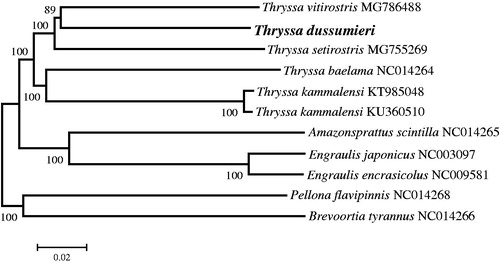Abstract
In this study, the complete mitochondrial genome (mitogenome) sequence of Thryssa dussumieri was determined by long polymerase chain reaction and primer walking methods. The mitogenome was a circular molecule of 16,883 base pairs (bp) in length and contained 13 protein-coding genes (PCGs), 2 ribosomal RNA (rRNA), 22 transfer RNA (tRNA), and a control region similar to those found in other bony fishes. The overall nucleotide composition was estimated to be 32.1% A, 26.1% C, 23.7% T, and 18.1% G. The neighbor-joining tree was reconstructed based on the 13 PCGs sequences of T. dussumieri and other 10 Engraulidae species. The mitogenome data will provide useful information for further studies on the phylogenetic analysis and population genetics.
Thryssa dussumieri (Valenciennes, Citation1848) is a typical pelagic fish, belonging to order Clupeiformes, family Engraulidae, genus Thryssa. T. dussumieri is mainly distributed in the coast of Indo-Western Pacific, from East Sea of China to Pakistan and south to Borneo and Java (Whitehead et al. Citation1988). As a small fish, T. dussumieri plays an important role in marine ecosystems. However, there are few studies on the genetic features of T. dussumieri mitogenome. The complete mitogenome of T. dussumieri in this study would facilitate further phylogenetic analysis and population genetics.
The specimen of T. dussumieri was collected from the coast of Zhangzhou, China (118.2°E, 24.3°N) in 2013, and preserved in absolute ethanol at the Marine Biology and Ecology Laboratory, Third Institute of Oceanography, Ministry of Natural Resources (Xiamen). Total genomic DNA was extracted using a TIANGEN Marine Animals DNA Kit following the manufacturer’s protocol. The complete mitogenome sequence was determined by long polymerase chain reaction (PCR) and primer walking methods (Cheng et al. Citation1994). The assembled mitogenome was manually checked and deposited in the GenBank with the accession number MK344184.
The complete mitogenome of T. dussumier was sequenced to be 16,883 bp in length. It consisted of 13 typical protein-coding genes, 22 tRNA genes, 2 rRNA genes, and a control region. Gene arrangement was in accordance with other bony fishes (Cheng et al. Citation2012; Zhang et al. Citation2016). The encoding genes of mitogenome were located on the H-strand with the exception of ND6 and eight tRNA genes that were transcribed from the L-strand. The overall nucleotide composition of mitogenome was estimated to be 32.1% A, 26.1% C, 23.7% T, and 18.1% G, with anti-G bias and a slight excess of AT as observed in most fishes (Miya et al. Citation2003). The 13 protein-coding genes were totally 11,419 bp in size, accounting for 67.7% of the whole mitogenome. As observed in other mitochondrial genomes, 22 tRNA genes were identified ranging in size from 66 to 75 bp (Inoue et al. Citation2000). The mitogenome of T. dussumier also contained a small subunit rRNA (12S rRNA) and a large subunit rRNA (16S rRNA), which were 955 and 1698 bp in length, respectively. The control region was located between the tRNAPro and tRNAPhe genes. It was 1224 bp in length, where tandem repeated sequences were recognized. The control region contained termination-associated motif sequence (TAS), central conserved domain (CSB-F, CSB-E and CSB-D), and conserved sequence domain (CSB-1, CSB-2 and CSB-3).
Ten available complete mitogenomes of family Engraulidae were retrieved from Genbank to estimate the phylogenetic position of T. dussumier. The neighbor-joining (NJ) phylogenetic tree was reconstructed by MEGA 6.06 (Tamura et al. Citation2013) based on the concatenated nucleotide sequences of 13 PCGs. The NJ tree showed that all species could be easily distinguished from each other with high support values (). The genus Thryssa consisted of two clades: one clade contained Thryssa vitirostris, Thryssa setirostris and T. dussumier, another included Thryssa kammalensis and Thryssa baelama.
Disclosure statement
No potential conflict of interest was reported by the authors.
Additional information
Funding
References
- Cheng S, Chang SY, Gravitt P, Respess R. 1994. Long PCR. Nature. 369:684–685.
- Cheng J, Ma GQ, Song N, Gao TX. 2012. Complete mitochondrial genome sequence of bighead croaker Collichthys niveatus (Perciformes, Sciaenidae): a mitogenomic perspective on the phylogenetic relationships of Pseudosciaeniae. Gene. 491:210–223.
- Inoue JG, Miya M, Tsukamoto K, Nishida M. 2000. Complete mitochondrial DNA sequence of the Japanese sardine (Sardinops melanostictus). Fisheries Sci. 66:924–932.
- Miya M, Takeshima H, Endo H, Ishiguro NB, Inoue JG, Mukai T, Satoh TP, Yamaguchi M, Kawaguchi A, Mabuchi K, et al. 2003. Major patterns of higher teleostean phylogenies: a new perspective based on 100 complete mitochondrial DNA sequences. Mol. Phylogenet Evol. 26:121–138.
- Tamura K, Stecher G, Peterson D, Filipski A, Kumar S. 2013. MEGA6: molecular evolutionary genetics analysis version 6.0. Mol Biol Evol. 30:2725–2729.
- Valenciennes A. 1848. Histoire naturelle des poissons. vol. 21. Imprimerie royale, Paris.
- Whitehead PJP, Nelson GJ, Wongratana T. 1988. FAO species catalogue. Vol. 7. Clupeoid Fishes of the World (Suborder Clupeoidei). Part 2: Engraulididae. FAO Fish Synop. 125:305–579.
- Zhang N, Song N, Han Z, Gao TX. 2016. The complete mitochondrial genome of Coilia nasus (Clupeiformes: Engraulidae) from the coast of Ningbo in China. Mitochondrial DNA. 27:1518.

